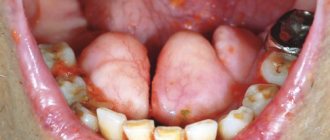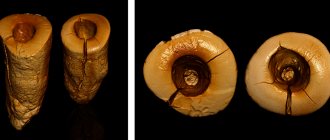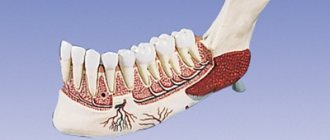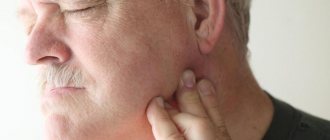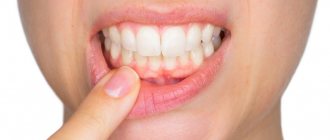1.What is facial pain and classification of prosopalgia?
Facial pain
(“prosopalgia” from the Greek prosopon - face and algos - pain) - refers to a number of symptoms that cause diagnostic difficulties. The surface of the face and its internal structures have many nerve endings and nodes, and pain in them can be associated with the face itself or other organs and parts of the body.
Since the face contains organs related to several body systems, several medical specialists can study and treat facial pain (ENT, ophthalmologist, neurologist, surgeon, dentist). Facial pain can be part of some syndromes, the symptom complex of which affects not only the facial areas. Facial pain can be unilateral or symmetrical.
According to its genesis, facial pain can be classified into the following groups:
- neuralgic pain (somatalgia);
- pain caused by vascular disorders, for example, migraine (sympathalgia);
- muscle pain;
- soreness of the facial bones;
- skin pain;
- osteochondrotic pain;
- pain of inflammatory origin;
- traumatic and post-traumatic pain.
A must read! Help with treatment and hospitalization!
Migraine
The most common cause of pain, translated from Latin as “half of the head.” This disease disrupts the functioning of the blood supply, due to which a sufficient amount of nutrients does not reach the brain. The symptoms of migraine are quite simple - continuous, sometimes throbbing pain on one side of the face and head, which may be accompanied by nausea.
An increase in pain may occur with a sharp increase in sound or bright light
2. Symptoms and diagnosis
In addition to the pain syndrome, facial pain can be accompanied by a number of disorders that can help identify the causes. However, it should be borne in mind that these manifestations may be a reaction to the pain itself (an attempt to compensate for an unpleasant condition) and not be signs of certain diseases. Facial pain may be accompanied by the following disorders:
- facial asymmetry;
- muscle tension;
- swelling of the nose and runny nose;
- itching, swelling, redness of the skin;
- nervous tics;
- impaired sensitivity to smells, loss of taste;
- decreased visual acuity;
- increased body temperature;
- tearfulness;
- dry mouth or eyes;
- noise in ears.
The pain itself can be shooting, dull, aching, localized or migrating, radiating to other parts of the head, neck, back
.
“aura”
may be observed - a state when the perception of the surrounding reality is distorted (from altered smells to visual images at the edges of the visible area).
If facial pain is accompanied by a feeling of “heat,” nausea, and pulsation of blood vessels, then the cause of the pain may be an exacerbation of hypertension.
Sometimes the face hurts in combination with numbness in areas of the skin. These symptoms may indicate a stroke, vegetative-vascular dystonia, cervical osteochondrosis, and neuropsychic disorders.
When pain is accompanied by phenomena characteristic of certain diseases, diagnosis should be aimed at confirming or excluding the suspected diagnosis. However, quite often even a thorough examination does not reveal obvious causes of facial pain. In this case, they talk about “atypical facial pain”
. Presumably, its nature lies in the plane of neurological and mental disorders. Such pain can recur throughout life, and at different periods with different frequencies. Most likely, stress and other conditions of modern life disrupt the production of certain neurotransmitters, which affects the skin, blood vessels, nerve conduction and excitability in the facial area.
When visiting a doctor with facial pain, the following diagnostics may be prescribed:
- examinations aimed at identifying trigeminal neuralgia;
- assessment and localization of muscle soreness;
- examination of the skin and mucous membranes (often a herpetic infection of the nose can cause facial pain);
- measurement of intraocular and intracranial pressure;
- radiography, MRI and CT to detect diseases of bones, gums, teeth;
- general blood test (to identify inflammatory diseases by the level of leukocytes and ESR).
Visit our Neurology page
Atypical facial pain
This category includes diseases that can only be diagnosed through medical research. Pain on the right side of the face
Most often, if the right side of the face and right eye hurt, it is caused by bruises or an infection that leads to inflammatory processes. Everything here is extremely simple: dysfunction of tissues leads to painful sensations. If the focus is located on the right side of the face, then the pain will gradually spread throughout this area.
Why does the eyeball hurt when pressed?
Particular attention should be paid to inflammatory processes on the left side of the face. To people who have not experienced this problem, it may seem very confusing how pain can be felt exclusively in one area of the face and head. However, such cases occur quite often. The primary cause of pain may be migraine. This pathology often also affects the left eye and temples.
A fairly common cause of pain in the left area of the face and head is osteochondrosis of the neck. Pressure on the arteries that supply blood to the brain can cause pain. This is caused by the fact that the beneficial substances that nourish the brain are not supplied in the required quantities, which provokes the appearance of spasms. Symptoms may include pressure surges, pain in the temples and around the eyes.
If the left side of the face and eyes hurt, you should immediately consult a doctor, because often the pain does not subside, but spreads throughout the face and head
3.Treats for facial pain
When your face hurts, you should not self-medicate until you see a doctor. Even taking painkillers should be postponed, although most often after an examination the doctor prescribes something for the symptomatic treatment of pain. The fact is that the picture and nature of pain are an important diagnostic criterion, so a blurry picture of facial pain will complicate the examination and making a correct diagnosis.
If during the diagnosis it is possible to determine the cause of facial pain, then treatment of the causative disease is prescribed, and, as a rule, the pain goes away when a therapeutic effect is achieved. This does not exclude the use of painkillers at the beginning of treatment, since prosopalgia can be quite painful and lead to disturbances in sleep and performance.
Treatment of atypical pain that does not have a specific cause includes the drugs carbamazepine, finlepsin, mazetol
and others used for trigeminal neuralgia.
In addition, a psychological examination is indicated, identifying the triggers for pain, and psychocorrection sessions. Physiotherapy can also be a good addition
- magnetic and laser therapy;
- electrophoresis with analgin and lidase;
- electrosleep;
- treatment with diadynamic currents;
- hydrocarbon treatment.
About our clinic Chistye Prudy metro station Medintercom page!
Diagnostics
The cause of pain in the cheekbone is determined by the maxillofacial surgeon. According to indications, the patient is referred to an otolaryngologist, neurologist, and other specialists. During the survey, the time and circumstances of the onset of the symptom, the dynamics of its development, and the presence of other manifestations indicating the nature and localization of the pathological process are established. During the dental examination, dental diseases are excluded.
When determining the etiology of neuropathic pain, an important role is played by the study of trigger points and special tests (for example, with dicaine and adrenaline for ganglionitis of the pterygopalatine ganglion). To clarify the diagnosis, the following procedures are prescribed:
- Radiography.
X-ray examination of the zygomatic bone, orbit or maxillary sinus is used for injuries, osteomyelitis, sinusitis, and pansinusitis. Allows you to establish the type and severity of the pathology, determine the need to prescribe additional techniques or treatment tactics. - Other imaging techniques
. They are used at the final stage of the examination when X-ray data are ambiguous. Provide detailed information about the location, characteristics and extent of the pathological focus. - Otolaryngological examination
. Indicated for ENT diseases. May include anterior rhinoscopy, diagnostic puncture and probing of the maxillary sinus. - Lab tests
. Inflammation is characterized by leukocytosis with a shift to the left and an increase in ESR. In purulent processes, based on the results of inoculating the material on nutrient media, the pathogen is determined and antibiotic sensitivity is established.
Dental treatment
Facial pain associated with dental damage
Sometimes a person's face may hurt due to problems related to dental health.
The following pathologies can lead to such pain:
- Deep caries.
- Pulpitis.
- Periodontitis.
- Periodontitis complicated by an abscess.
- Osteomyelitis.
Often the source of pain cannot be identified the first time. An increase in discomfort when eating too hot, cold or sour food can lead to the idea that it occurs due to dental damage. Possible increase in body temperature. Treatment should be carried out by a dentist.
Sometimes facial pain occurs after a bad tooth has been treated.
In this case, it can indicate various complications, including:
Trigeminal neuropathy. It is possible that he was hurt during treatment.
- Inflammation of the tooth root due to unprofessional actions of the dentist.
- Attachment of purulent infection.
- Leaving foreign objects in the tooth canals.
- Poor quality tooth extraction.
You absolutely should not endure such pain; you must contact your dentist as soon as possible.
Facial pain associated with muscle tissue damage
The face hurts if the person’s facial muscles, chewing muscles, and neck muscles are affected.
The following disorders can provoke such pain:
- Incorrect bite causes damage to the chewing muscles, jaws and teeth.
- Frequent emotional turmoil. At such moments, people clench their jaws tightly, which causes pain.
- Neurological and mental disorders. In this case, the nerve centers that regulate muscle tone are affected. This can lead to severe pain.
- Osteochondrosis of the upper spine. The pain spreads to the neck, occipital muscles and facial muscles.
- Received soft tissue injuries. This also includes injuries to the temporomandibular joint.
To find the source of pain, you need to consult a neurologist. Treatment of such pathologies comes down to taking sedatives and muscle relaxants. Physiotherapy is effective.
Pain caused by skin diseases
The skin of the face may hurt in the following cases:
- There was a soft tissue injury.
- A malignant tumor develops on the face - melanoma. Often this neoplasm appears from a mole when its cells degenerate.
- Acne, that is, blackheads, can hurt. This is especially true for rashes that are located deep under the skin. You can get rid of acne using antiseptic and antibacterial creams and lotions. You need to take proper care of your skin.
- An allergic reaction such as angioedema may be accompanied by facial pain. At the same time, the person’s eyes and soft tissues become red and watery. The larynx becomes very swollen, which can lead to suffocation.
Sometimes facial pain can be associated with reasons that are not related to any diseases. Thus, the face and scalp may hurt due to wearing elastic bands and hairpins that are too tight.
When facial pain is associated with neuralgia
With neuralgia, irritation of the facial nerve occurs. It may be subject to pressure from various neoplasms, dilated vessels, or inflammatory reactions. It also happens that the cause of neuralgia cannot be determined.
The pain will vary depending on which nerve is affected.
- Damage to the facial nerve.
The facial nerve rarely causes pain, since it is responsible largely for motor rather than sensory activity. However, if his neuritis develops, the person will experience pain on one side of the face. Other symptoms of the lesion include impaired facial expressions, facial asymmetry, an increase in the size of the eye neck, distortion of taste and pain behind the ear. To determine the cause of the pathology, a consultation with a neurologist is necessary.
- Trigeminal neuralgia.
The trigeminal nerve is the main nerve responsible for sensation in the face. Three branches branch off from it. The pain will vary depending on which branch is affected.
The main symptoms of damage to the trigeminal nerve:
- The pain is paroxysmal and does not last long - about 2 minutes.
- The man’s face seems to sting from the inside. The pain is very intense and makes the patient suffer.
- Pain occurs on one side of the face.
- The pain can radiate to the jaw, neck, ears, and even the index finger. This largely depends on how and where the facial nerve runs in a person.
- If the trigeminal nerve is damaged, the patient's face may twitch like tics.
- When the attack ends, nothing bothers the person.
- Neuralgia of other facial nerves.
The human face is riddled with other nerves. Therefore, pain in this area can be caused by their damage:
- Pain in the tongue, face, throat and tonsil area develops if the glossopharyngeal nerve is affected. This disorder can be caused by eating very hot or very cold foods.
- Pain on one side of the face and in the larynx can be caused by damage to the superior laryngeal nerve. In addition, the person suffers from coughing attacks, increased salivation, and hiccups.
- The face, as well as the teeth, eyes and jaw, will hurt when the pterygopalatine nerve ganglion is affected. At the same time, he suffers from an incessant runny nose, his tears flow, his face swells, his eyes turn red.
- Pain in the face localized behind the eyes and between them occurs if the nasociliary nerve is affected. The patient changes the size of the palpebral fissure and is bothered by rhinitis. This nerve becomes inflamed very rarely.
To clarify the cause of pain, you need to contact a neurologist. Treatment involves taking antiepileptic and painkillers. If medication correction does not cope with the problem, the patient is referred for surgery.
Video: a program about the most important thing - trigeminal neuralgia:
All these pathologies are diagnosed and treated by a neurologist.




